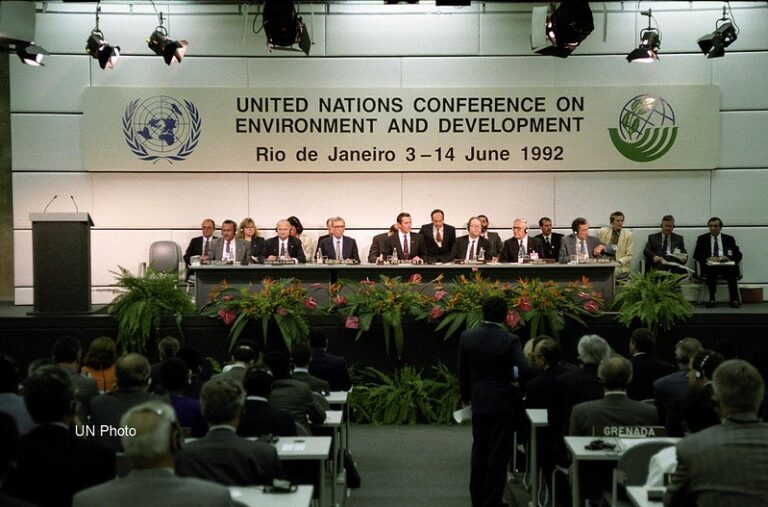What is the UN Framework Convention on Climate Change (UNFCCC)?

Signed in 1992, the United Nations Framework Convention on Climate Change (UNFCCC) is the foundational treaty that has provided a basis for international climate negotiations since it was established, including landmark agreements such as the Kyoto Protocol (1997) and the Paris Agreement (2015). The Convention has been ratified by 197 states who have committed to act on climate change and regularly report on their progress.
What does the UNFCCC say?
The ultimate goal of the Convention is the “stabilisation of greenhouse gas concentrations in the atmosphere at a level that would prevent dangerous anthropogenic interference with the climate system” within a timeframe that allows people and planet to adapt and economies to develop sustainably. In joining the Convention, Parties acknowledge the existence of the threat of climate change and agree to undertake efforts to combat it.
The Convention itself has not established concrete targets. Rather, it was intended to provide a framework for future agreements and policies. The Convention calls for ongoing research, negotiations, agreements and obligations through a few important mechanisms:
1. Common but differentiated responsibility
The Convention recognises the principle of common but differentiated responsibility (CBDR) and respective capability. This principle acknowledges that different states have different capabilities and responsibilities to address climate change and this can be used as a framework to navigate the balance between the need for all states to act on climate change, with their varying levels of responsibility for greenhouse gas emissions – both past and present – and capacity to address that problem in a way that is “equitable and appropriate”.
The Paris Agreement refers to “common but differentiated responsibilities and respective capabilities, in the light of different national circumstances”, and reflects both the shifting landscape of countries’ emissions – for example, the dramatic rise in China’s emissions since 1992 – and changing capacity to address climate change as economies, technologies and policies develop.
2. Establishing major institutions, structures and processes
The Convention lays out a basic structure through which the Parties can work together to achieve its goals.
- The Conference of the Parties is the supreme body to regularly review, devise, agree and implement climate policy.
- A secretariat coordinates the sessions of the Conference of the Parties, prepares reports and compiles information, providing particular assistance to developing countries.
- Subsidiary bodies provide scientific and technological advice and assess how well the Convention is being implemented.
Subsequent agreements under the UNFCCC, such as the Kyoto Protocol and Paris Agreement, have established additional institutions, such as the Green Climate Fund, specialised climate change funds and technical committees. These institutions provide the technical, advisory and financial advice to develop policies and guidance and support the implementation of the Convention, the Kyoto Protocol and the Paris Agreement.
3. Data-gathering, knowledge-building and clear communication
Knowledge-building plays a huge role in the UNFCCC process. Parties are required to gather and share data to build evidence, set goals and track progress on greenhouse gas reduction. Developed countries must also submit detailed mitigation strategies and their expected outcomes. This process has been crucial in building a robust body of knowledge and scientific understanding of climate change and the impact of various mitigation strategies, which has helped inform subsequent policies and significant international agreements such as the Paris Agreement.
Public understanding and participation are also essential to achieving national and international transformation, and the Convention requires countries to promote climate education, awareness and training to the public.
What has been the impact of the UNFCCC?
From its inception in 1992, the UNFCCC has led to the adoption of a number of subsequent agreements. It has spurred the development of key infrastructure and policies at the international and national levels that serve as cornerstones of today’s climate action, including measuring and tracking and reporting emissions and impacts; generating knowledge and research; and building the capacity to address the causes and effects of climate change. The most recent major development in the UN climate change agenda has been the adoption of the Paris Agreement, produced at the 21st session of the Conference of the Parties (COP21) in 2015. And in 2021 nations adopted the Glasgow Climate Pact, which aims to “turn the 2020s into a decade of climate action and support”.

